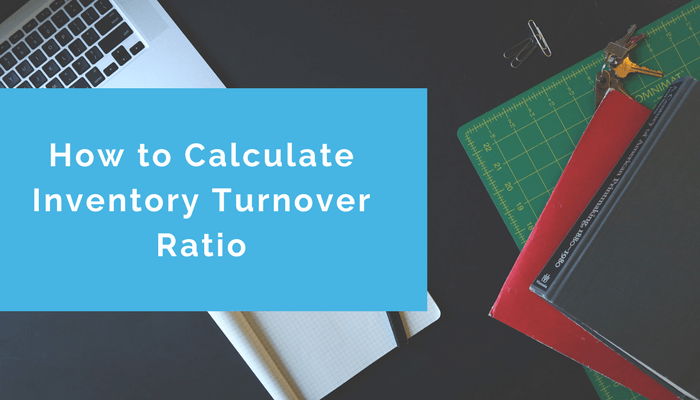How to calculate Inventory Turnover Ratio

Inventory turnover ratio helps you in evaluating how well the management is working in managing the inventory and generating sales from it.
It is the measure of how quickly your business sells through its inventory in a given period of time and needs to replace it again.
It is also known as inventory turns, stock turn and stock turnover.
Managing the optimum inventory levels is essential for every business.
Inventory turnover is a financial ratio which depends on
- Cost of Goods Sold (COGS)
- Average Inventory
Calculating The Financial Ratio
1. Deciding the Inventory Turnover Period
Inventory turnover is calculated over a certain time period.
The time period can range from one single day or an entire year or it can be a particular week. We cannot calculate inventory turnover at a particular instant.
After deciding the time period, we have to take the cost of goods and average inventory also of that same time period only.
Otherwise, you won’t be comparing apples to apples, and your inventory turnout won’t be accurate.
2. Calculating the Cost of Goods Sold( COGS)
Cost of goods sold is the direct total expense associated with the production of goods sold or the cost of the goods you acquire to sell to the customers.
How do we calculate it?
COGS = Beginning Inventory + Purchases Made During the entire time period- Ending Inventory
Let us take an example, a company has
- Beginning inventory = $2,000,000
- Purchases during the entire time period =$1,500,000
- Ending inventory= $700,000
- Cost of Goods Sold= $2,800,000
COGS includes only the direct costs associated which are as follows:
- Cost of raw materials and inventory used in the production of the goods.
- Labor charges
- Cost of items purchased for the resale of the good
- Cost of facilities used to make the product
- Freight in and out
It does not include the:
- Overhead expenses like shipping, distribution
- Office space, etc.
You can learn in detail about Inventory Costing here
3. Finding Average inventory
Calculating average inventory is simple, add the starting inventory and ending inventory together. Divide the sum by 2.
- The formula Average inventory= Ending Inventory formula is also used. But that does not give an accurate output because the company’s inventory keeps on fluctuating.For example, a company might buy a lot of goods at the beginning of the year and then sell it throughout the year. The entire inventory will be sold by the end of the year.So the ending balance will not reflect the actual average inventory for the year.
- Use multiple data points for a more accurate answer, since two points do not always represent all the changes that occurred in inventory the entire year. So many businesses calculate their average inventory on monthly basis for a year plus a base month, providing 13 points.
4. Apply the Inventory Turnover Formula
Inventory turnover can also be calculated using the formula
Inventory turnover = Sales / Inventory

Sales are calculated on the price offered to the customers. On the other hand, inventory is calculated at lower wholesale costs.
So this formula can end up giving you higher turnover value than the actual one.
Application and Interpretation of Inventory Turnover in your Business
1. Using Inventory Turnover to Calculate Average Days to Sell a Product
Inventory turnover period in simple words is also known as the average number of days required to sell a product.
How do we calculate it?
Average Days to Sell a Product= 365 / Inventory Turnover
For example, we calculated the inventory turnover ratio. And the result was 10 for a given year.
So now Inventory Turnover period will be equal to 365 days/10, we get 36.5 days. So the average number of days required to sell an entire stock will be 37 days.
- Average Days to Sell a Product is different for different industries.
- Businesses that sell perishable goods have lower inventory days than the business selling non-perishable goods. Like supermarkets or groceries, stores have lower inventory days than the business that sells furniture or appliances.
2. The Ideal Inventory Turnover Ratio
- High inventory turnover indicates fast moving inventories and efficient operations.
- Low inventory turnover means that the company’s goods are spending a lot of time being stored in the warehouse. This leads to:
- Increased holding cost: The company will have to spend more money on rent, utilities and other various other maintaining costs on goods.
- Lower profit and net income: If the holding costs increases then expenditure will also increase which in turn will result in lower profit and net income.
3. Consider Ideal Turnover According to the Product Type
As mentioned in the first point ideal turnover is based on the nature of the business and the type of product you sell. Items with high turnover are good because there are many products that tend to expire soon or get out of season quickly.
Especially perishable goods like grocery, bakery and other food business need to have highest inventory turnover. Otherwise, they tend to get bad or stale after a certain amount of time.
Also in the fashion industry, clothes tend to get out of fashion quickly.
4. Very High Inventory Turnover is Also not Good
Usually high inventory turnover indicates high sales. But at times that is not true, especially for non-perishable goods.
In this case, it can indicate that you are not stacking the right amount of goods to meet the need of your customers.
For example, you have a cosmetic business, a lipstick of a particular brand is selling out the same day it comes in stock.
So that means that you need to increase the number of lipsticks you are ordering of that particular brand so that the high demands.
Conclusion
To sum it up, the role of inventory turnover is vital in planning future measures.
Since its calculation involves precise figures your resources must be authentic. Inventory turnover ratio helps you to identify the problem areas in within your inventory so that you can take actions to improve it.
As per the product, you need to keep inventory turnover in check so as to match demand and supply. The Optimal Inventory Turnover Ratio varies from company to company.
We hope this article helped you learn about inventory turnover. So that this knowledge could help you make better decisions with business inventory in the future, resulting in better sales volumes and higher profits.







